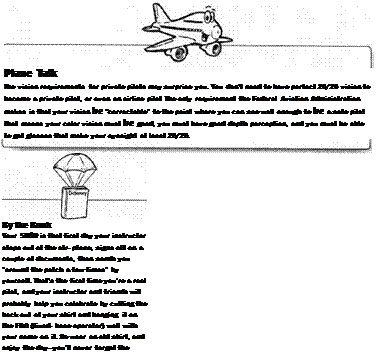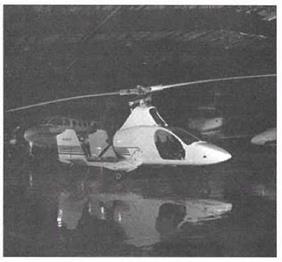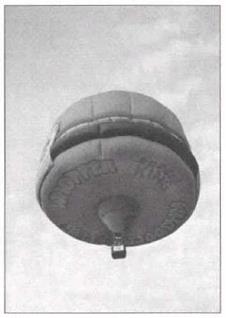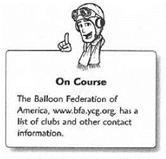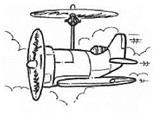A Word About Sunglasses
One item you probably should spend a little bit of money on is sunglasses. Don’t be tempted by the low-quality, high-fashion ones you can buy at the local shopping mall. Manufacturers like Vuarnet and RayBan put a lot of research into making sure that their lenses have no distortion and their tint doesn’t alter the color of objects. They also design their glasses to work comfortably when worn with a headset.
|
On Course Here’s a money-saving suggestion: Take a look at the pilots’ bulletin board at your local airport Many of your fellow pilots will post notices of items they are selling, and you can pick up some excellent bargains. Also, don’t forget the Internet auction sites, which will probably have some of the merchandise you want at bargain-basement prices. |
Remember, this is flying we’re talking about. You’ll be facing directly into the sun a good deal of the time. You’ll also be flying above the clouds, where the sunshine reflecting off snow-white cloud tops can be blinding. You’ll have to be able to see clearly, no matter what. This is no time to skimp on quality.
Because you want good sunglasses, you should be ready to pay a fair price. RayBans, which set the standard for cockpit attitude with its sunglasses a few years back, retail for $65 or more. Classic Aviators by Serengeti will run you more than $100, and Serengetis are probably worth even more than that for their durability and incredible ability to tame the sun. Of course, if you’re like me and wear glasses, you’ll have to have the lenses ground to your prescription strength, which adds still more cost.
There are plenty of other things you’ll want to buy, from “My Other Car Is an Airplane” bumper stickers (don’t) to a good flight bag to carry all the tools of the trade (do). You’ve been warned—this game can get expensive.
Winning Your Wings: Instruction
Now it’s time to talk about the most expensive part of your investment—the ground school, the flight instructor, and the airplane. Here, again, there are times to skimp and times to open up your pocketbook.
Ground School
Ground-school training is the time you spend in a classroom or in one-on-one academic instruction with your instructor. Ground-school training is just as important as flight time when it comes to molding a safe, mature pilot. For that reason, this is no time to pinch pennies.
|
|
|
By the Book An FBO, or fixed-base operator, is the airport business where you can rent an airplane, sign up for a flight-training course, find a flight or ground instructor, buy pilot supplies and aviation fuel, rest between flights, plan out your next flight, check on the weather, and even have a donut and coffee before that early morning takeoff. Most airports, even those in small towns, have an FBO, and large airports might have several. |
If one-on-one ground school fits your budget, ask around for the very best ground – school instructor, then contact him or her and get together for a chat. Find out if your personalities match, yes, but most important, find out if he or she has the serious, focused approach you want in a ground instructor. You don’t want a ground instructor who will spend his time—which means your money—telling you stories about his adventures in the air or whose lessons veer into irrelevancies.
Don’t be afraid to interview your ground instructor, just as you shouldn’t be shy about interviewing your flight instructor and the operator of the FBO where you rent your training plane. Ask to see his certificates, and ask for the names of previous or current students so you can interview them about the instructor.
This isn’t like learning to drive, where your first teacher was your dad or one of the unlucky teachers who was stuck teaching driver’s education in high school. In your flight training, it’s your own money you’re spending, and the stakes in terms of safety and cost are much higher. Take your time and choose a high-quality instructor.
The costs of one-on-one ground school instruction can add up. Expect to pay $30 per hour or more for as much as 20 hours of instruction.
The least expensive path through ground school is to join a small class of fellow student pilots. This approach has other advantages besides lower cost. For example, students can meet outside class to discuss lessons, something that could help you keep up your stamina and enthusiasm.
Ground- school courses are offered by most FBOs, and some community colleges offer them for the low price of a continuing education course.
During ground school, you’ll learn the basic principles of flight, the aviation environment such as airspace, airport and radio communications, airplane mechanical systems and performance capabilities, weather theory, how to read and interpret weather charts, basic and radio navigation, flight physiology, and how to plan a flight and make sound decisions.
If these topics pique your curiosity and fire up your intellect, “Get thee to an airport! ”
Flight Instructor
Choosing a competent, professional flight instructor is perhaps the most important thing you’ll do as a pilot in training. You’ll never forget your first flight instructor, and you’ll want to remember him or her for all the right reasons. Too often, pilots use flight instructing as a stepping stone to other jobs, and that means their first priority is not how well their students are learning, but how many flight hours they’ve been able to get in a cockpit, where every tick of the clock adds to their resume and brings them closer to an airline job.
Again, spend time with a prospective instructor, maybe over a cheeseburger and fries at the airport coffee shop. What do you want in a flight instructor? You want him to put your training on the top of his priority list and to have an enthusiasm for flying that is contagious, that will rub off in the cockpit.
Here again, don’t squeeze your nickels too hard. The higher price of a very good flight instructor is an investment in your enjoyment of flying for the rest of your life.
For that reason, don’t be afraid to keep looking if you have any reservations about a potential flight instructor. Your training is too important—and too expensive—to settle for second-best.
In most cases, your instructor’s hourly fee, about $25 to $30 per hour, will be included in the total cost of your private pilot training course. If it’s not, make sure you add the instructor costs to the cost of renting your training plane. You’ll realistically need 20 to 30 flight hours of instructor time, and another 20 to 30 hours of flying alone, to get your certificate.
















